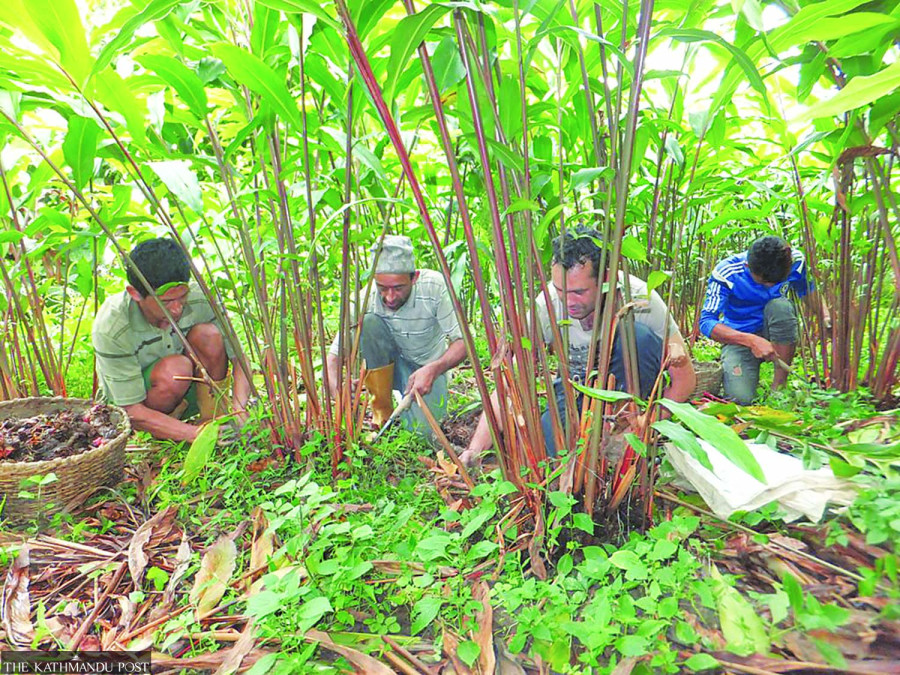Money
Large cardamom likely to see sharp fall in output
The Federation of Large Cardamom Entrepreneurs say the output this year may drop 40 percent-on year, mainly due to drought and pest infection.
Ananda Gautam
The Federation of Large Cardamom Entrepreneurs expects a sharp fall in output this year, mainly due to drought and pest infection.
The association of large cardamom buyers said the output may drop by a staggering 40 percent, year-on-year.
Nirmal Bhattarai, central president of the federation, said drought and the outbreak of diseases may affect the production this year.
The large cardamom prices, meanwhile, have been increasing.
“As the producers have already sold their spice which they had stored, the demand may spike in the months ahead,” said Bhattarai. “We will not be able to fulfil the demand of the international buyers this year.”
The large cardamom, with a bigger seed, is currently being traded at Rs925 per kg in the market in Birtamod, Jhapa.
According to the federation, 8,000 tonnes of large cardamom is produced annually in Nepal.
The cultivation is being done in 53 districts with Taplejung the highest producer.
But this year, the large cardamom production in Taplejung is expected to drop by 60 percent, said Balmani Baral, president of Large Cardamom Zone, Taplejung. “The large cardamom production has been hit by pests in the mountain region. In the hills, the drought may affect productivity,” he added.
Taplejung’s annual production stands at 2,900 tonnes, according to the statistics of the agriculture zone.
There are 61 wards in Taplejung district and large cardamom is not produced in only two wards.
The large cardamom farmers have demanded that the government control pests and provide irrigation facilities to increase production.
Krishna Labung of Paktanglung Rural Municipality-4 said that without pesticides, the crop wouldn’t yield. He, however, said that farmers should be made aware of applying organic pesticides.
Organic pesticides are made by using mugwort (bitter leaf) and cow manure.
The large cardamom zone has provided assistance for farmers applying organic pesticides in Hangdeva of Phungling Municipality-9, Phaktanglung-3, in Lelep of Likhim and Fungling-6, said Baral.
Normally, large cardamom is harvested from September to December.
Large cardamom is planted mostly on sloped terraces.
The large cardamom price had reached a record Rs3,000 per kg in 2014-2015.
Large cardamom is mainly exported to India as well as Pakistan and to the Gulf countries like Saudi Arabia, Qatar and the UAE, via India.
Studies have shown that Nepal can produce 35,000 tonnes of large cardamom, but there should be a smart and robust farming system in place. The government has not invested much in large cardamom, which is one of the country’s high-value export items.
Nepal exported 5,367 tonnes of large cardamom worth Rs4.81 billion in the last fiscal year.
Large cardamom is cultivated predominantly in four districts of eastern Nepal—Taplejung, Panchthar, Ilam and Sankhuwasabha—which account for more than 80 percent of national output. Around 60,000 families are involved in growing it.
Large cardamom is being grown in Dadeldhura and Lamjung too.
Besides Nepal, this high-value spice is also cultivated in India and Bhutan.
More than 90 percent of the large cardamom grown in Nepal is exported to India, traders said.
The Nepali large cardamom or black cardamom has a distinct flavour profile due to a specific method of post-harvest drying in bhattis (ovens), which explains its roasted smell and taste.
The smoky flavour would overwhelm a sweet cake or pudding, but in a spice rub for roasted meat or in a full-flavoured stew, it imparts a smouldering depth no other spice can, according to experts.
As India prefers to import non-processed cardamom for a cheaper price, Nepal has been exporting non-processed cardamom. India then processes, packages and brands the spice and sells it at a higher price.




 18.12°C Kathmandu
18.12°C Kathmandu















